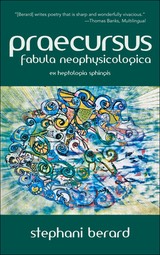by Stephen Berard
The Sphinx Heptology (Heptologia Sphingis) carries the message of quantum holism. In telling his amusing stories, Berard endeavors to propagate that famous notion, repeatedly confirmed by physics experimentation, that each so-called “part” of the universe is simultaneously both part and whole, that everything in the cosmos is directly linked with everything else at the quantum level, and that things happening “here” are expressed one way or another in all “places”; that indeed, due to the proven phenomenon of quantum non-locality, the idea of “separate places” is an illusion...or, when seen in their wholeness, they are parts of a virtual hologram whose information is contained in no space. Berard has found fantastic realism, of all the literary styles, to be the most appropriate for conveying these ideas to his readers.
CAPTI: Fabula Menippeo-Hoffmanniana Americana

Product Details | Book Preview PDF ePUB
Available in print (hardcover and paperback on acid-free paper) and eBook editions through the Cataracta Store.
In Capti, the first book of the Sphinx Heptology, Stephen Berard weaves a multicultural, particolored, sometimes surreal and often hilarious tapestry of satire, magic realism, myth, science, and poetry. The central character is a highly functional autistic Seattle ballet dancer, Woody Fava, who speaks in verse and uses chromoptic therapy in the form of colored eyeglasses to help himself make sense of his world. In search of the Goddess, whom he is sure has recently moved into a condo somewhere in Seattle, Woody quits his ballet job, quickly impoverishes himself, and has a series of disturbing misadventures, until finally disappearing...only to reemerge in Los Angeles at the center of a bizarre murder mystery.
PRAECURSVS: Fabula Neophysiologica (expected 2017)

Book Preview PDF
In Praecursus, the reader comes to a greater understanding of how the diffuse compositional style of Capti is actually describing a first impression of an extremely holistic world view in which absolutely everyone and everything is directly connected to everyone and everything else...as well as how personality and individual identity can be viewed as somewhat arbitrary and even artificial constructs.
The central character is Tog, a praecursor engaged by a race of benevolent artificial super-beings to explore the possibilities of biological entities operating in the next higher dimensional level of existence in which there are four degrees of physical freedom and time is experienced in the fifth dimension. As Tog navigates through different stories and worlds — at times living fused with a hive-minded entity and existing now as a hologram, now as a computer subroutine — he learns to ride the waves of quantum flux...and eventually even to control them to a large extent.
EOS: Carmen Methistoricum
Set mostly in the Eastern Mediterranean of the 4th Century C.E., Eos will be more of a poem-cum-prose-poem (like Daemonologia and Sphinx) — a poetic-fantastic meditation on the contrasts between Eastern and Western worldviews as experienced by a pair of ancient philosophers.
DAEMONOLOGIA: Carmen Synaestheticum
Like the supermassive black hole swallowing whirling stars at the center of a large galaxy, Daemonologia is a highly fantastic poem-cum-prose-poem at the center of the Heptologia Sphingis that will tackle the issue of how an individual may or may not survive the overwhelming fact of an infinity of universes, realities, deities, and demons.
CAELA PONE CAELA: Fabula Cubistica
This novel offers multiple stories — some cinematic and some occurring in the supposedly real world — intersecting in cubistic style with a segmented biography of 1940s child actress Peggy Anne Garner, whose life presents a poignant example of the roller coaster ride that is Hollywood.
TANTISPER: Fabula Neoheroica
The Tantisper fable explores the distinction between religion and spirituality, addressing such existential questions as: Why do unembodied entities want to visit the physical plane in the first place? Why is Universal Consciousness so wrapped up in making up worlds? Does all this activity benefit anyone?
SPHINX: Carmen Arcanum
Is reality a hostile “thing” out there reminiscent of the way Francis Bacon described “science,” i.e., the natural world as we see it, a Sphinx ready to tear us apart? This poem balances — or perhaps floats —somewhere between spiritual parable and metaphysical poetry à la Eliot’s Four Quartets in an attempt to explain who or what the Sphinx really is.